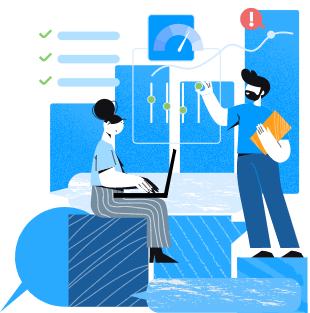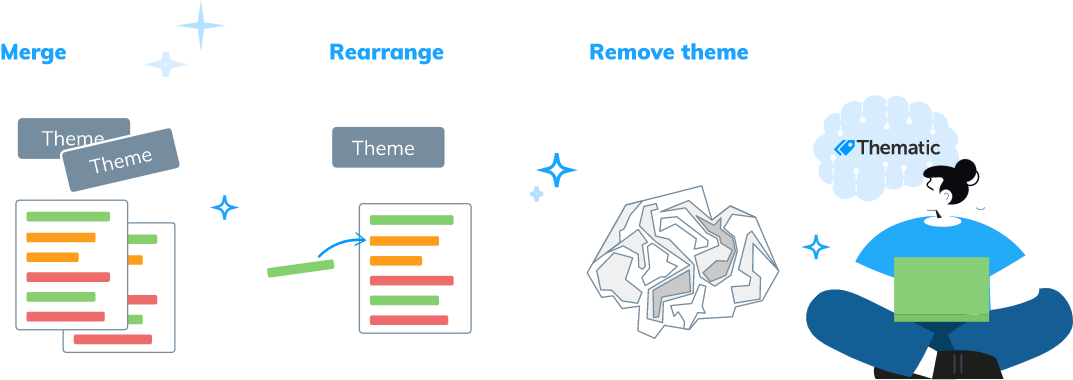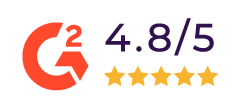How Thematic makes sense of your text feedback
When you have a lot of text feedback, like open-end survey responses, app review comments or twitter threads, how do you begin to make sense of it all?
The best way to analyze a large volume of qualitative feedback is to uncover themes in the data. This is called thematic analysis.
Thematic is a feedback analytics platform that automates thematic analysis. Built specifically for customer feedback, it allows you to see and understand themes clearly, while saving weeks of work.
In this overview, we’ll break down the jargon and help you understand how Thematic makes sense of feedback, so you can unlock actionable insights. [If you’re looking for a thematic analysis deep dive, we’ve covered the topic in more detail here.]

How is thematic analysis approached in Thematic?
To analyze the text and uncover the themes from the data and context in which they arise, Thematic uses natural language processing (NLP) and deep learning. Our NLP is on the most advanced level possible, but we refer to it simply as the AI engine behind Thematic.
The sophistication of our AI means you don’t have to set up code-frames or train models in advance. You just need to add or connect your data to the Thematic platform and the AI does the heavy lifting. Select which columns of data you want to analyze, and you’ll be up and running with analysis results within hours.
Curious what we mean when we say sophisticated? Our AI discovers everything your customers are talking about even if it isn’t in a framework you’ve developed. It picks up nuance too, such as people sharing positive feedback couched in negative language.
While all the analysis in Thematic is automated, you can easily interact with the data and trace the themes back to the original feedback. You can also use the drag and drop tools within the platform to refine themes, to make sure the analysis is useful for the question you’re answering and the stakeholders.
What is the step by step process for thematic analysis in Thematic?
We’ve broken down the analysis process into five broad steps to give you an easy overview. These steps closely resemble the stages a researcher follows when performing analysis manually.


First up is finding meaningful phrases by scanning the text. There’s a lot of ‘noise’ in customer feedback, so our AI pre-cleans the data by finding comments or phrases that are useful to your company.
Let’s have a look at a piece of feedback like “Thank you for fixing chat in landscape mode, and the navigation is easy to use”.
The meaningful phrases here are:
- “fixing chat”
- “chat in landscape mode”
- “landscape mode”
- “navigation”
- “navigation is easy”
- “easy to use”
Thematic extracts these phrases while at the same time putting aside the noise (words like “thank you” or “and”).
At this stage, we don’t yet know if ‘chat in landscape mode’ is the basis of an insight or theme, because a theme only emerges when multiple people mention it.


Next, our AI uncovers themes from the phrases used in your dataset. Natural language processing is key here: Thematic can quickly see when people are saying the same thing, even when they use different phrases.
In a manual thematic analysis approach, you would repeat these first two steps several times to check all the phrases have been captured, and captured in the right way. Thematic software repeats this automatically.


Our AI now groups the themes into a hierarchy, also known as a taxonomy or a code-frame. In Thematic, the AI scans the long list of themes, along with the context in which the theme was mentioned, and suggests a hierarchy which a company can accept or refine.
How the themes are grouped and organized depends on other themes in the dataset. For example, the sub-theme “easy to use navigation” could be grouped under a base theme of “ease of use” or a base theme of “navigation”. If customers also talk about other features that are easy to use, it’s more likely to be grouped with ease of use. Or if they talk in-depth about navigation as well as ease of use, the broad theme is more likely to be navigation.


Next, we double check each theme has enough data to support it. Each theme must be distinct, useful and actionable. Thematic enables you to visually trace themes to phrases and raw feedback quotes, so that anyone can look at the feedback for context. This is important to build understanding and empathy with customers, as well as for quality checking.
The capability to easily refine and quality control themes is paramount in all thematic analysis, and no less important when powered by AI. Since the context isn’t always clear from the piece of feedback, the AI may occasionally miss the exact meaning of a phrase, requiring some theme editing.
Within Thematic, you can merge similar themes, and remove themes that lack enough data to back them up. This step ensures the analysis is accurate and is tailored to meet your specific product, marketing or operations team use case. It’s a reassuring and easy process for customers with editor permissions or the customer success team.
We call this a hybrid or augmented, human-in-the-loop approach. Allowing human refinements following the AI analysis ensures Thematic delivers on speed, accuracy and reducing bias while also being flexible.

Now it’s time to identify actionable insights and discover what your customer feedback data tells you. As part of thematic analysis, themes are quantified so you can see top mentioned themes. When you include scores, such as CSAT or app rating, in the data variables, Thematic analyzes and shows you which themes most affect satisfaction or ratings.
A review of the top themes, and the context in which they arise, will help you to form a narrative and identify key insights. With statistical analysis tools and filters, you can dig into the main themes impacting NPS or customer satisfaction, and understand key issues your customers are raising. You can choose vivid, relevant quotes from customers to back up your points.
There’s a strong element of interpretive analysis in forming a narrative and finding insights, so you can draw on the driver analysis, statistical changes and relationships between the themes. Dashboards pull all of this together, so you can share a summary with stakeholders and make an argument for your insights.
Where can you learn more about Thematic analysis software?
We’ve put together a lot of resources to help you learn how thematic analysis software works. These show you how it makes sense of feedback at scale, and how you can use it to improve products, experiences and your bottom line. Here are a few ways to learn more:
 Product management
Product management
 Support operations
Support operations
 Customer Experience
Customer Experience
 Insight & Research
Insight & Research
 People management
People management


